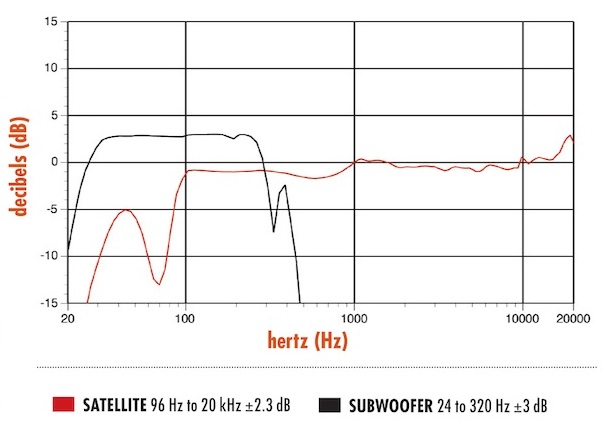Test Report: Paradigm MilleniaOne Speakers & MilleniaSub Subwoofer Page 4

Frequency response (at 2 meters)
satellite 96 Hz to 20 kHz ±2.3 dB
sub 24 to 320 Hz ±3 dB
Sensitivity (SPL at 1 meter with 2.8 volts of pink-noise input)
satellite 84 dB
Impedance (minimum/nominal)
satellite 3.3/6 ohms
Bass output, sub (CEA-2010 standard)
Ultra-low bass (20-31.5 Hz): 83.7 dB
Low bass (40-63 Hz): 111.8 dB
Bass limit, satellite
63 Hz at 86 dB
Measurements of the MilleniaOne were made at 1 meter, ample distance to ensure that full effects of cabinet diffraction and front-panel reflections were included. The measurements shown in the graph were taken with the speaker grilles removed. The speaker was placed on a 6-foot stand. These tests gave quasi-anechoic results down to 220 Hz. The curve you see in the graph shows an averaged response from 0° to 30°, smoothed to 1/12th-octave. Responses of the woofer and port were close-miked, scaled, and summed, then spliced to the quasi-anechoic response. The subwoofer’s two drivers were close-miked, and their responses were summed to produce the curve you see here.
The measurements of the MilleniaOne satellite are extraordinary. On-axis response is admirably flat, but the off-axis response is simply amazing. Even at 60° off-axis, there’s almost no difference in the response except the expected treble roll-off (about -2.5 dB at 10 kHz). The measurements are essentially the same whether the speaker is standing up or turned on its side, a truly remarkable achievement I’ve never before witnessed except in concentric speakers (such as many models from KEF and Pioneer) that place the tweeter inside the woofer. Okay, they’re not quite as good when the speaker is on its side; the worst anomaly in the ±60° measured window occurs at 45° off-axis on the woofer side, where there’s a dip of about -4.5 dB at 10 kHz. The grille’s effects are mild, causing a dip of -1 to -2 dB between 6.5 kHz and 12 kHz, but as I stated in the review, this dip is audible.
There’s no magic to these great measurements: They’re due to the use of a small woofer with broad dispersion well into the lower treble; the use of a fairly low crossover point of 2.2 kHz, which lets the tweeter carry all of the treble and takes advantage of the smaller driver’s superior dispersion; the close spacing of the drivers, which minimizes driver interference; and the steep third-order (18 dB/octave) crossover, which also reduces interference. Most two-way speakers with 4-inch woofers use shallower crossovers, maybe symmetrical second-order or first-order on the woofer and second -order on the tweeter; and most use a much higher crossover point, typically around 3 to 3.5 kHz. These compromises allow them to use a cheaper tweeter and fewer crossover parts. Better for the manufacturer, worse for you. Paradigm deserves praise for taking the high road in a product category where few others do.
Sensitivity of the MilleniaOne is a little on the low side; the averaged output at 1 meter from 200 Hz to 10 kHz in my quasi-anechoic measurements was 84 dB. Impedance is also a little low, dropping to 3.3 ohms at 290 Hz and averaging about 6 ohms, with a maximum phase shift of -51° at 170 Hz. But you’re not going to push these little guys all that hard (I hope), so I doubt you’ll have a problem getting good listening levels even with a cheap receiver.
The MilleniaSub is also a surprisingly nice piece of engineering, although compromised to fit its attractive form factor. It’s optimized for output in the upper octave and doesn’t have much output in the lower octave, but I consider that a wise choice because the weird drivers don’t have enough excursion to deliver really kick-ass bottom end. Low bass output (40-63 Hz) averages an impressive 111.8 dB, but ultra-low bass output (20-31.5 Hz) averages just 83.7 dB. Incredibly, the MilleniaSub hits 118.5 dB at 63 Hz, but its output falls fast below that. Close-miked frequency response is nice and flat, with enough high-frequency response to mate well with the MilleniaOne satellite. Combined low-pass function of the drivers, enclosure, and subwoofer crossover filter is about -30 dB/octave.
The Perfect Bass Kit worked pretty much as advertised. These auto-bass EQ things tend not to do much when the sub is in my room’s “subwoofer sweet spot,” so I put the MilleniaOne in the corner, which caused sharp peaks centered at 40 and 85 Hz, and a broad peak between 120 and 160 Hz, as measured on a laptop running TrueRTA software with a calibrated microphone. The PBK reduced these peaks by -13 dB, -7 dB and -2 to -4 dB, respectively, delivering a nearly flat response. The corner positioning also caused a deep, narrow suckout centered at 55 Hz, which the PBK wisely didn’t try to fix. (You can only fix a suckout by moving the sub or your chair; pumping more energy into these “sonic black holes” accomplishes nothing except perhaps burning out your subwoofer.) However, the PBK’s corrections made the suckout much shallower relative to the rest of the response, so it did end up helping the problem. The only downside is that the PBK costs $299; for that price, you could buy an equalizer and a measurement rig for your computer.
Bottom Line
I’m thrilled that at long last a speaker manufacturer decided to build a lifestyle system with all the care and quality it normally lavishes on its cost-is-no-object gear. After an hour, I was convinced that the Paradigm MilleniaOne/MilleniaSub combo is one of the best lifestyle systems I’ve reviewed. And after 4 hours, I was convinced it’s one of the best speaker systems I’ve reviewed.




























































